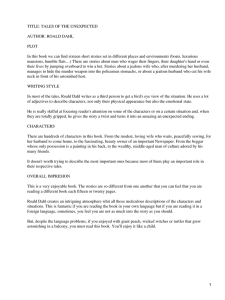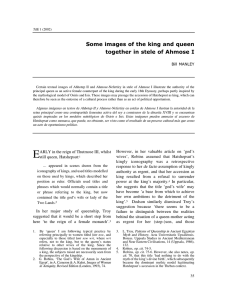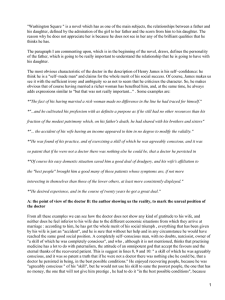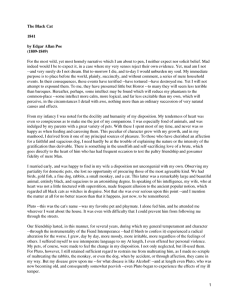New Kingdom 50
Anuncio
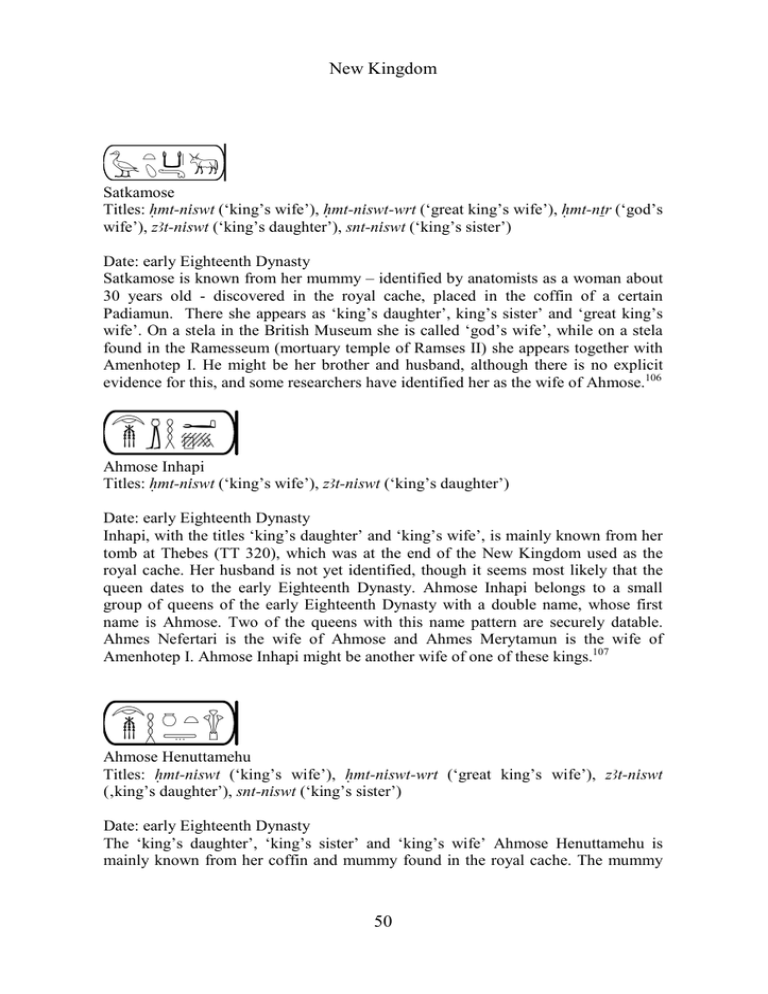
New Kingdom Satkamose Titles: Hmt-niswt (‘king’s wife’), Hmt-niswt-wrt (‘great king’s wife’), Hmt-nTr (‘god’s wife’), zAt-niswt (‘king’s daughter’), snt-niswt (‘king’s sister’) Date: early Eighteenth Dynasty Satkamose is known from her mummy – identified by anatomists as a woman about 30 years old - discovered in the royal cache, placed in the coffin of a certain Padiamun. There she appears as ‘king’s daughter’, king’s sister’ and ‘great king’s wife’. On a stela in the British Museum she is called ‘god’s wife’, while on a stela found in the Ramesseum (mortuary temple of Ramses II) she appears together with Amenhotep I. He might be her brother and husband, although there is no explicit evidence for this, and some researchers have identified her as the wife of Ahmose.106 9 Ahmose Inhapi Titles: Hmt-niswt (‘king’s wife’), zAt-niswt (‘king’s daughter’) Date: early Eighteenth Dynasty Inhapi, with the titles ‘king’s daughter’ and ‘king’s wife’, is mainly known from her tomb at Thebes (TT 320), which was at the end of the New Kingdom used as the royal cache. Her husband is not yet identified, though it seems most likely that the queen dates to the early Eighteenth Dynasty. Ahmose Inhapi belongs to a small group of queens of the early Eighteenth Dynasty with a double name, whose first name is Ahmose. Two of the queens with this name pattern are securely datable. Ahmes Nefertari is the wife of Ahmose and Ahmes Merytamun is the wife of Amenhotep I. Ahmose Inhapi might be another wife of one of these kings.107 7 Ahmose Henuttamehu Titles: Hmt-niswt (‘king’s wife’), Hmt-niswt-wrt (‘great king’s wife’), zAt-niswt (‚king’s daughter’), snt-niswt (‘king’s sister’) Date: early Eighteenth Dynasty The ‘king’s daughter’, ‘king’s sister’ and ‘king’s wife’ Ahmose Henuttamehu is mainly known from her coffin and mummy found in the royal cache. The mummy 50 New Kingdom showed that she died an old lady. The name Ahmose supports an early Eighteenth Dynasty date. 108 Ahmose Nefertari Titles: iryt-pat (‘member of the elite’), wrt-imAt (‘great of grace’), wrt-Hzwt (‘great of praises’), mwt-niswt (‘king’s mother’), Hmt-niswt-wrt (‘great king’s wife’), Hmt-nTr (‘god’s wife’), Xnmt-nfr-HDt (‘the associate of the white crown bearer'), zAt-niswt (‘king’s daughter’), snt-niswt (‘king’s sister’) Husband: Ahmose The ‘king’s daughter’, ‘great king’s wife’ and ‘king’s mother’ Ahmose Nefertari is the wife of Ahmose and the mother of Amenhotep I. After her death she was worshipped together with Amenhotep I and other members of the royal family in Thebes as a local deity. Her original burial place has not yet been located. Her coffin was found in the royal cache, and is an impressive example of a rishi coffin carved in wood. Rishi coffins (from the Arabic word rishi meaning ‘feather’) show the whole body of the dead wrapped in feathers. The coffin type is very common in the Second Intermediate Period but was in the Eighteenth Dynasty restricted to royal coffins. She is the first royal woman to bear the title ‘god’s wife’. The title was so important that it was even in contemporary inscriptions often her only title. Her nurse with the name Rai is known from a coffin found in the Royal Cachette at Deir el-Bahari.109 (Ahmose) Merytamun (I) Titles: nbt-tAwy (‘mistress of the two lands’), Hmt-niswt (‘king’s wife’), Hmt-niswtwrt (‘great king’s wife’), Hmt-nTr (‘god’s wife’), Hnwt-tAwy-tm (‘lady of the entire land’), Xnmt-nfr-HDt (‘the associate of the white crown bearer’), zAt-niswt (‘king’s daughter’), snt-niswt (‘king’s sister’), In later sources: mwt-niswt (‘king’s mother’) Husband: Amenhotep I The ‘great king’s wife’ Ahmose Merytamun is mainly known from three sets of sources. There is her tomb found in Deir el-Bahari; she appears in later sources, in connection with worship of the early Eighteenth Dynasty royal family; and there are various other objects mentioning her. In the later sources she is associated with Amenhotep I, Ahmose Nefertari, the ‘king’s son’ Sapair and the ‘king’s daughter’ and ‘king’s sister’ Satamun (a sister of Ahmose Merytamun). From this evidence it seems certain, that she was the wife of Amenhotep I. She bears the titles ‘king’s daughter’ and ‘king’s sister’ and was therefore most likely the daughter of Ahmose 51 New Kingdom Nefertari and of king Ahmose as her brother and husband is Amenhotep I. Her burial was found in the early twentieth century by Winlock and still contained two well preserved impressive coffins. One of them was very similar to the coffin of Ahmose Nefertari, indicating that they were produced at about the same time.110 Ahmose Titles: iryt-pat (‘member of the elite’), wrt-Hzwt (‘great of praises’), nbt-bnrt-aA(t)mrwt (‘mistress of great beloved sweetness’), Hmt-niswt-wrt-mryt.f (‘great king’s wife, his beloved’), Hnwt-nDm-ib (‘mistress of gladness’), Hnwt-Hmwt-nbwt (‘lady of all women’), Hnwt-tAwy (‘lady of the two lands’), zmAyt-Hrw (‘companion of Horus’), smrt-Hrw-mryt.f (‘beloved friend of Horus’), snt-niswt (‘king’s sister’), Husband: Thutmose I Ahmose is the wife of Thutmose I and the mother of the ruling queen Hatshepsut. She is not known from many monuments but in the temple of her daughter Hatshepsut is described the royal birth of the latter. Ahmose is depicted as pregnant, while the god Amun is shown coming to Ahmose and being the father of queen Hatshepsut. The scene seems to have played an important part in legitimating the ruling queen Hatshepsut as king. Nothing is known about the origin of queen Ahmose, although her name might indicate some relation to the royal family of the early Eighteenth Dynasty where the name Ahmose was very popular. However, she does not bear the title ‘king’s daughter’, indicating a non-royal origin.111 Mutneferet Titles: mwt-niswt (‘king’s mother’), Hmt-niswt (‘king’s wife’) Husband: Thutmose I The ‘king’s wife’ and ‘king’s mother’ Mutneferet was a lesser wife of Thutmose I and the mother of Thutmose II. She is not known from many monuments. A fragment of a stela and a statue found at Karnak mention her in connection with Thutmose II as ‘his mother’.112 52
